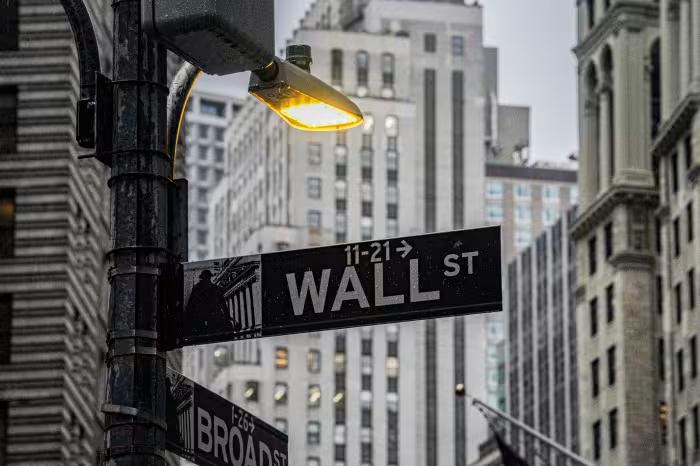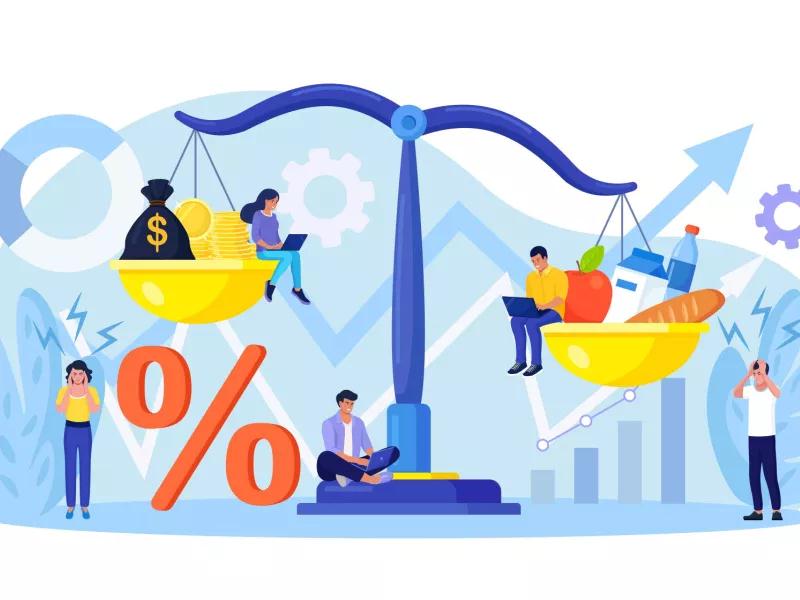The Dow Jones, as it is often known, and whose full official name is the Dow Jones Industrial Average or Dow Jones Industrial Average (DJIA), is an index that tracks the 30 largest companies that are publicly traded on the New York Stock Exchange. (The New York Stock Exchange) and the Nasdaq stock exchange.
The Dow Jones index is named after the surnames of its creators, journalists Charles Dow and Edward Jones, who founded the Wall Street Journal and Dow Jones & Company, and who created this index in 1896.
Often referred to as “The Dow” or the “Dow Jones,” the Dow Jones Industrial Average is one of the oldest and most closely watched indices in the world, and includes companies such as the Walt Disney Company, Exxon Mobil Corporation, and Microsoft Corporation. When news networks say “the market is up today,” they are generally referring to the Dow Jones index.
Understanding the concept of the Dow Jones
The Dow Jones Industrial Average was designed to serve as a broad view of the American economy. When the index was launched it only included 12 companies that were almost purely industrial in nature. These companies operated railroads, cotton, gas, sugar, tobacco and oil. It is the second oldest index in the United States after the Dow Jones Transportation Average.
As the economy is constantly changing, so has the composition of this index. The Dow Jones typically makes changes when a company becomes less representative of the economy (for example, when it loses market capitalization due to financial difficulties) or when a broad economic change occurs and that change needs to be reflected in the index.
History
Precursors
In 1884, Charles Dow composed his first stock average, which contained nine railroads and two industrial companies that appeared in the Customer’s Evening Letter, a two-page daily financial news bulletin that was the precursor to The Wall Street Journal. On January 2, 1886, the number of stocks represented in what is now the Dow Jones Transportation Average decreased from 14 to 12, as the Central Pacific Railroad and the New Jersey Central Railroad were eliminated. Although it comprised the same number of stocks, this index contained only one of the original twelve industrials that would eventually form the more famous Dow index.
Initial components
Charles Dow calculated his first purely industrial stock average on May 26, 1896, creating what is now known as the Dow Jones Industrial Average. None of the original 12 industrialists are still part of the index.
These are the 12 companies that appeared in the first Dow Jones index:
- American Cotton Oil Company, a predecessor company to Hellmann’s and Best Foods, now part of Unilever.
- American Sugar Refining Company, became Domino Sugar in 1900, now Domino Foods, Inc.
- American Tobacco Company, divided in a 1911 antitrust action.
- Chicago Gas Company, purchased by Peoples Gas Light in 1897, now an operating subsidiary of Integrys Energy Group.
- Distilling and livestock feeding company, now Millennium Chemicals, formerly a division of LyondellBasell.
- General Electric, still in operation, removed from the Dow Jones Industrial Average in 2018.
- Laclede Gas Company, still in business as Spire Inc, was removed from the Dow Jones Industrial Average in 1899.
- National Lead Company, now NL Industries, removed from the Dow Jones Industrial Average in 1916.
- North American Company, an electric utility holding company, delisted by the United States Securities and Exchange Commission (SEC) in 1946.
- Tennessee Coal, Iron and Railroad Company in Birmingham, Alabama, purchased by US Steel in 1907; US Steel was removed from the Dow Jones Industrial Average in 1991.
- United States Leather Company, disuelta en 1952.
- United States Rubber Company, changed its name to Uniroyal in 1961, merged with privately held Goodrich Corporation in 1986, purchased by Michelin in 1990.
How is this index calculated?
Stocks with higher prices have a higher weight in the index. So, a higher percentage change in these actions will have a greater impact on the final calculated value. When the Dow Jones was launched, Charles Dow calculated the average by adding the stock prices of the twelve companies included in the index and then dividing by twelve, resulting in a simple average. Over time, there have been additions and subtractions to the index, such as acquisitions and divisions of companies that have had to be taken into account by the index, and where arithmetic calculation is simply no longer sufficient.
This led to the introduction of the Dow Divisor, a predetermined constant (although it can be changed if the need arises) that is used to determine the effect of a one-point move in any of the thirty companies that make up the index. There have been instances (components added or removed, company splits, etc.) when the divisor needs to change so that the value of the Dow Jones index remains consistent. The current divisor is
The key point about the Dow Jones is that it is not an arithmetic average of the thirty most representative companies, as is the S&P 500 index. Instead, it reflects the sum of the price of a stock in the market for all its components, divided by the divider. Therefore, a one point movement in any company in the market (included in the index) will move the index by an identical number of points.
Changes in the index over time
The index grew to 30 companies in 1928 and has changed the number of companies included in it by a total of 51 times. The first change occurred just three months after the index was launched. In its early years, until approximately the Great Depression, there were many changes in its components. In 1932, eight companies within the Dow Jones were replaced. However, during this change, Coca Cola Company and Procter & Gamble Co. were added to the index, two companies that are still part of the index in 2019.
The largest recent change in the Dow Jones took place in 1997, when four of the companies included in the index were replaced. Two years later, in 1999, four more companies were changed. The most recent change to the index took place on June 26, 2018, when Walgreens Boots Alliance, Inc replaced General Electric Company.
Investment methods in the Dow Jones
Investing in the Dow Jones index is possible through index funds, as well as through derivatives, such as options contracts and futures contracts.
Investment and listed funds
The easiest way to indirectly invest in the Dow Jones Industrial Average is to buy an index fund that tracks its daily movement. A mutual fund or exchange-traded fund (ETF) can track, before fees and expenses, the performance of the index by holding the same stocks as the index, in the same proportions. Some ETFs use leverage or short strategies to increase price movements.
Futures contracts
In the derivatives market, the CME Group through its subsidiaries, the Chicago Mercantile Exchange (CME) and the Chicago Board of Trade (CBOT), issues futures contracts; the E-mini Dow ($5) Futures (YM), which tracks the average and trades on their exchange floors respectively. Trading typically takes place in an open outcry auction, or on an electronic network such as CME’s Globex platform.
Options contracts
The Chicago Board Options Exchange (CBOE) issues options contracts on the Dow through the root symbol DJX. Options on several underlying Dow ETFs are also available for trading.
Important historical events in the Dow Jones
The following are some of the most important historical events that have affected the Dow Jones:
May 26, 1896: The Dow Jones Industrial Average begins publication, including 12 companies. At that time the index registered 40.94 points.
October 24, 1929: Crash of ’29 , the Dow Jones index begins to fall from 400 points until reaching 198 points in mid-November 1929
March 15, 1933: The largest one-day percentage gain in the index occurred during the bear market of the 1930s, totaling 15.34 percent. The Dow gained 8.26 points and closed at 62.10.
October 19, 1987 : The largest one-day percentage drop occurred on Black Monday. The index fell 22.61 percent. There were no obvious explanations behind the event, although changing trading programs may have been a contributing factor.
September 17, 2001 : The fourth-largest one-day point drop, and the largest at the time, occurred on the first day of trading following the September 11 attacks in New York City. The Dow fell 684.81 points or about 7.1 percent. However, it is important to note that the index had been falling before 9/11, losing more than 1,000 points between January 2 and September 10. Despite this, the Dow Jones began to gain strength after the attacks and regained everything it lost, closing above the 10,000 mark by the end of the year.
September 29, 2008 : The Dow Jones falls by 6.98%, with a drop of 777.68 points amid the subprime mortgage crisis affecting Europe and the United States.
May 3, 2013: The Dow surpassed the 15,000 mark for the first time in history.
January 25, 2017: The Dow closed above 20,000 points for the first time.
January 4, 2018: The index closed at 25,075.13, the first close above 25,000 points.
January 17, 2018: The Dow closed at 26,115.65, the first close above 26,000 points.
February 5, 2018: The Dow fell a record 1175.21 points.
September 21, 2018: The index reached a record high of 26,743.50 points.
December 26, 2018: The Dow recorded its largest point gain in a day, this being 1086.25.
July 12, 2019: Dow Jones’ highest record to date at 27,332 points.
Recent history of the index
On September 17, 2001, the first day of trading after the 9/11 attacks, the Dow fell 7.1%. However, the Dow began an upward trend shortly after the attacks, and quickly regained all lost ground to close above 10,000 points for the year. In 2002, the Dow fell to a 4-year low of 7,286 on September 24, 2002 due to the 2002 stock market crash and the lingering effects of the dot-com bubble. Overall, while the NASDAQ fell about 75% and the S&P 500 fell about 50% between 2000 and 2002, the Dow only fell 27% during the same period. In 2003, the Dow remained stable within the 7,000 to 9,000 level and recovered to the 10,000 mark by the end of the year.
The Dow continued to rise and reached a record high of 14,198.10 points on October 11, 2007, a mark that was not reached again until March 2013. It then fell over the next year due to the financial crisis of 2007-2008.
On September 15, 2008, a broader financial crisis became evident when Lehman Brothers filed for bankruptcy along with the economic effect of record oil prices that had reached nearly $150 per barrel two months earlier. The Dow lost more than 500 points for the day, returning to its mid-July lows below 11,000. A series of rescue packages, including the Emergency Economic Stabilization Act of 2008, proposed and implemented by the Federal Reserve and the US Treasury Department did not prevent further losses. After nearly six months of extreme volatility during which the Dow experienced its largest one-day point loss, its largest daily point gain, and its largest intraday range (of over 1,000 points) at that time, the index closed at a new 12-year low of 6,547.05 on March 9, 2009, its lowest close since April 1997. The Dow had lost 20% of its value in just six weeks.
Towards the second half of 2009, the average recovered towards the 10,000 level amid optimism that the recession of the late 2000s, the US housing bubble, and the financial crisis of 2007–2008 were easing. and possibly coming to an end. Over the decade, the Dow saw a fairly substantial pullback to a negative return from 11,497 to 10,428 points, a loss of just over 9%.
2010s -2019
During the first half of the 2010s, aided by the Federal Reserve’s loose monetary policy, including quantitative easing, the Dow made a notable recovery attempt. This was despite significant volatility due to growing global concerns such as the 2010 European sovereign debt crisis, the 2009 Dubai World debt suspension and the 2011 US debt ceiling crisis.
On May 6, 2010, the Dow lost 9.2% during the day and recovered almost all of it in a single hour. This event, known as Flash Crash 2010, generated new regulations to prevent future incidents.
Six years after its previous high in 2007, the Dow finally closed at a new record on March 5, 2013. It continued to rise over the next few years, more than 17,000 points until a brief 2015-16 stock market selloff in the second half of 2015. It then rebounded in early 2016 and rose over 25,000 points on January 4, 2018.
Volatility returned in 2018 when the Dow fell almost 20%. By early January 2019, the index had rapidly risen more than 10% from its Christmas Eve low.
Overall, in the 2010s, the Dow rose from 10,428 to 28,538 points for a substantial 174% gain.
2020
Despite the emerging coronavirus pandemic , the Dow continued its bull run from the previous decade before reaching a high of 29,551.42 on February 12, 2020 (29,568.57 intraday on the same day). The index slowly retreats through the rest of the week and into next week, before fears over the coronavirus and an oil price war between Saudi Arabia and Russia sent the index to new lows, posting several days of losses ( and profits) of at least 1,000 points, a typical symptom of a bear market as previously seen in October 2008 during the financial crisis. Volatility increased enough to cause multiple 15-minute trading stops. In the first quarter of 2020, the DJIA fell 23%, its worst quarter since 1987
Criticisms of the Dow Jones
As a criticism, it can be said that the Dow Jones is quite restricted, as it only includes 30 companies and there are more than 15,000 companies on the stock market, which is why today it is not considered representative of the economic reality of the United States.
Another criticism made is that the companies included in this index appear there for the value of their shares, but not for the size of the companies or their level of capitalization, which is why the index is highly speculative.











